Research
- A pair of melanocortin 3 receptor polymorphisms is associated with childhood body weight.
- Brain-Derived Neurotrophic Factor (BDNF) and Obesity in the Wilms Tumor Aniridia Genito-Urinary Anomialies and Mental Retardation (WAGR) syndrome:
- Children and adults with a relatively common single nucleotide polymorphism in a regulatory region of Brain-Derived Neurotrophic Factor are heavier.
- Interrupting sedentary behaviors to improve glucose tolerance in children.
- Typical Winter Holiday weight gain in adults is only 0.37 kg (0.8 lb).
- Binge eating in children is associated with greater food intake as well as high body weight and adiposity and the complications of obesity.
- Metformin Treatment in the context of a behavioral modification program may help significantly overweight children lose weight.
- Colchicine reduces inflammation and measures of insulin resistance in adults with metabolic syndrome.
See Also:
A pair of melanocortin 3 receptor polymorphisms is associated with childhood body weight.
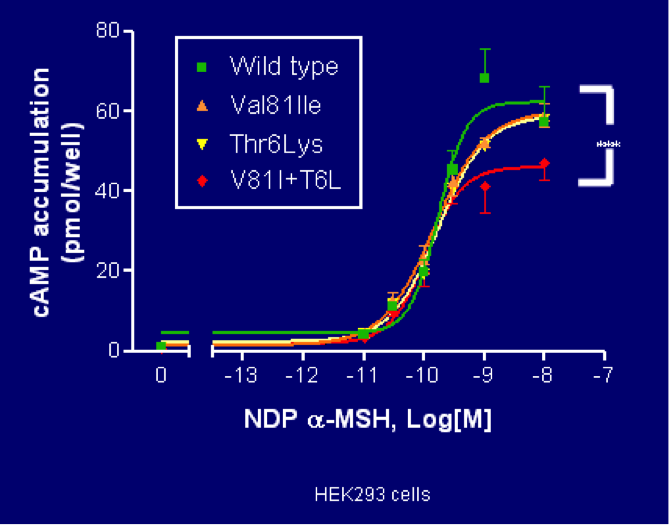 Among 355 overweight and non-overweight children, 8.2% were double homozygous for a pair of missense MC3R sequence variants that change the amino acid sequence of the MC3R protein (Thr6Lys and Val81Ile). Such children were significantly heavier (BMI and BMI SD score: p < 0.0001), had more body fat (body fat mass and percentage fat mass; p < 0.001) and had greater plasma leptin (p < 0.0001) and insulin concentrations (p < 0.001) and greater insulin resistance (p < 0.008) than wild type or heterozygous children. Both sequence variants were more common in African American than Caucasian children. In vitro expression studies found the double mutant MC3R was partially inactive, with significantly fewer receptor binding sites, decreased signal transduction and less protein expression. Diminished MC3R expression in this double MC3R variant may be a predisposing factor for excessive gain in body weight in children. Feng N, Young SF, Aguilera G, Puricelli E, Adler-Wailes DC, Sebring NG, Yanovski JA. Co-occurrence of two partially inactivating polymorphisms of MC3R is associated with pediatric-onset obesity. Diabetes 2005;54(9):2663-7. PMC1861848
Among 355 overweight and non-overweight children, 8.2% were double homozygous for a pair of missense MC3R sequence variants that change the amino acid sequence of the MC3R protein (Thr6Lys and Val81Ile). Such children were significantly heavier (BMI and BMI SD score: p < 0.0001), had more body fat (body fat mass and percentage fat mass; p < 0.001) and had greater plasma leptin (p < 0.0001) and insulin concentrations (p < 0.001) and greater insulin resistance (p < 0.008) than wild type or heterozygous children. Both sequence variants were more common in African American than Caucasian children. In vitro expression studies found the double mutant MC3R was partially inactive, with significantly fewer receptor binding sites, decreased signal transduction and less protein expression. Diminished MC3R expression in this double MC3R variant may be a predisposing factor for excessive gain in body weight in children. Feng N, Young SF, Aguilera G, Puricelli E, Adler-Wailes DC, Sebring NG, Yanovski JA. Co-occurrence of two partially inactivating polymorphisms of MC3R is associated with pediatric-onset obesity. Diabetes 2005;54(9):2663-7. PMC1861848
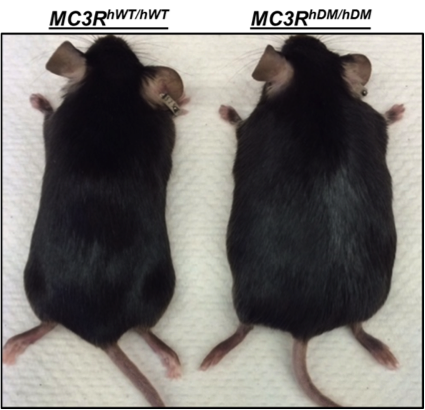 Mice with the murine Mc3r replaced by human double-mutant MC3R (MC3RhDM/hDM) are also heavier and shorter than mice carrying the wild type human MC3R gene (MC3RhWT/hWT). Mesenchymal stem cells differentiated into adipocytes from double-mutant mice appear to retain fatty acids as triglycerides more readily than the cells from wild type MC3R mice. Lee B, Koo J, Yun Jun J, Gavrilova O, Lee Y, Seo AY, Taylor-Douglas DC, Adler-Wailes DC, Chen F, Gardner R, Koutzoumis D, Sherafat Kazemzadeh R, Roberson RB, Yanovski JA. A mouse model for a partially inactive obesity-associated human MC3R variant. Nat Commun 2016;7:10522. PMC4738366
Mice with the murine Mc3r replaced by human double-mutant MC3R (MC3RhDM/hDM) are also heavier and shorter than mice carrying the wild type human MC3R gene (MC3RhWT/hWT). Mesenchymal stem cells differentiated into adipocytes from double-mutant mice appear to retain fatty acids as triglycerides more readily than the cells from wild type MC3R mice. Lee B, Koo J, Yun Jun J, Gavrilova O, Lee Y, Seo AY, Taylor-Douglas DC, Adler-Wailes DC, Chen F, Gardner R, Koutzoumis D, Sherafat Kazemzadeh R, Roberson RB, Yanovski JA. A mouse model for a partially inactive obesity-associated human MC3R variant. Nat Commun 2016;7:10522. PMC4738366
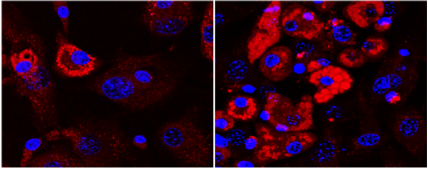
Mesenchymal Stem Cell differentiation with adipogenic medium: more lipid accumulation for MC3RhDM/hDM
Brain-Derived Neurotrophic Factor (BDNF) and Obesity in the Wilms Tumor Aniridia Genito-Urinary Anomialies and Mental Retardation (WAGR) syndrome:
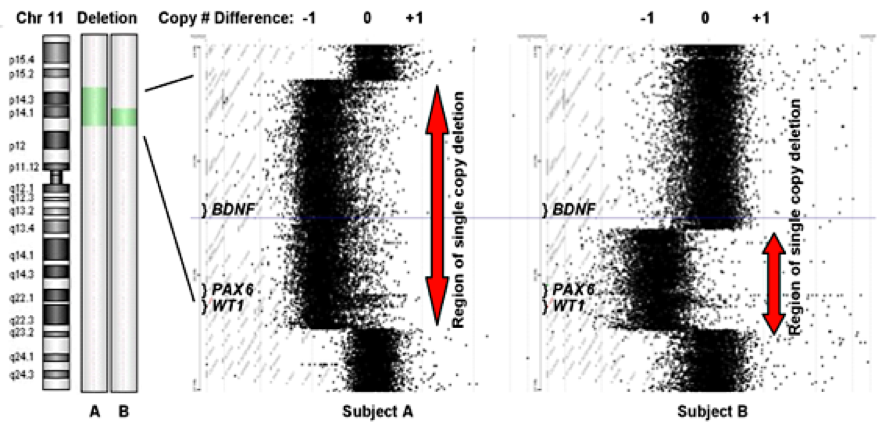 Subjects were categorized as BDNF haploinsufficient by comparative genomic hybridization. Subject A has a large deletion on chromosome 11 that removes one copy of the BDNF gene. Subject B has a smaller deletion that does not remove BDNF.
Subjects were categorized as BDNF haploinsufficient by comparative genomic hybridization. Subject A has a large deletion on chromosome 11 that removes one copy of the BDNF gene. Subject B has a smaller deletion that does not remove BDNF.
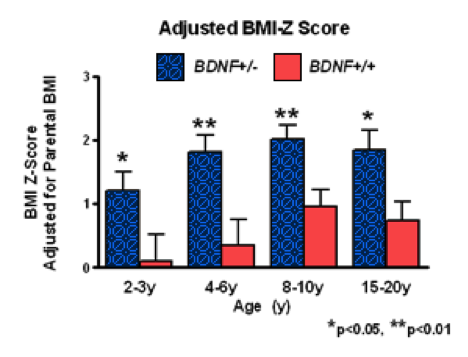
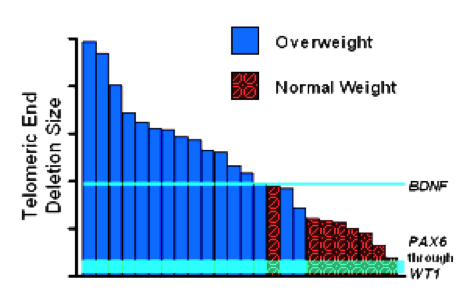
Patients with WAGR Syndrome who have haploinsufficiency for Brain-Derived Neurotrophic Factor (BDNF) had higher BMI standard deviation score (BMI Z-Score) than children and adults with WAGR Syndrome who retained two copies of BDNF. Deletions that extended into exon 1 of BDNF were associated with 100% risk of childhood-onset obesity. Han JC, Liu QR, Jones M, Levinn RL, Menzie CM, Jefferson-George KS, Adler-Wailes DC, Sanford EL, Lacbawan FL, Uhl GR, Rennert OM, Yanovski JA. Brain-derived neurotrophic factor and obesity in the WAGR syndrome. N Engl J Med 2008;359(9):918-27. PMC2553704
Children and adults with a relatively common single nucleotide polymorphism in a regulatory region of Brain-Derived Neurotrophic Factor are heavier.
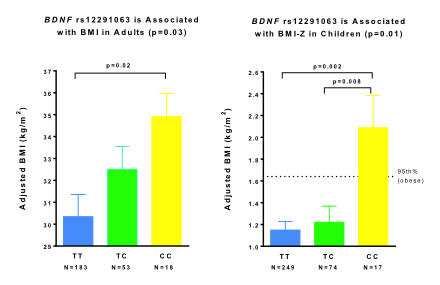 The minor C allele of rs12291063 was associated with lower human ventromedial hypothalamic BDNF expression (p < 0.001) and greater adiposity in both adult and pediatric cohorts (p values < 0.05). Further, the major T allele for rs12291063 possesses a binding capacity for the transcriptional regulator, heterogeneous nuclear ribonucleoprotein D0B (encoded by the HNRNP gene), knockdown of which disrupts transactivation by the T allele. Binding and transactivation functions are both disrupted by substituting C for T. These findings provide a rationale for BDNF augmentation as a targeted treatment for obesity in individuals who have the rs12291063 CC genotype. Mou Z, Hyde TM, Lipska BK, Martinowich K, Wei P, Ong CJ, Hunter LA, Palaguachi GI, Morgun E, Teng R, Lai C, Condarco TA, Demidowich AP, Krause AJ, Marshall LJ, Haack K, Voruganti VS, Cole SA, Butte NF, Comuzzie AG, Nalls MA, Zonderman AB, Singleton AB, Evans MK, Martin B, Maudsley S, Tsao JW, Kleinman JE, Yanovski JA, Han JC. Human Obesity Associated with an Intronic SNP in the Brain-Derived Neurotrophic Factor Locus. Cell Rep 2015;13(6):1073-80. PMC4644471
The minor C allele of rs12291063 was associated with lower human ventromedial hypothalamic BDNF expression (p < 0.001) and greater adiposity in both adult and pediatric cohorts (p values < 0.05). Further, the major T allele for rs12291063 possesses a binding capacity for the transcriptional regulator, heterogeneous nuclear ribonucleoprotein D0B (encoded by the HNRNP gene), knockdown of which disrupts transactivation by the T allele. Binding and transactivation functions are both disrupted by substituting C for T. These findings provide a rationale for BDNF augmentation as a targeted treatment for obesity in individuals who have the rs12291063 CC genotype. Mou Z, Hyde TM, Lipska BK, Martinowich K, Wei P, Ong CJ, Hunter LA, Palaguachi GI, Morgun E, Teng R, Lai C, Condarco TA, Demidowich AP, Krause AJ, Marshall LJ, Haack K, Voruganti VS, Cole SA, Butte NF, Comuzzie AG, Nalls MA, Zonderman AB, Singleton AB, Evans MK, Martin B, Maudsley S, Tsao JW, Kleinman JE, Yanovski JA, Han JC. Human Obesity Associated with an Intronic SNP in the Brain-Derived Neurotrophic Factor Locus. Cell Rep 2015;13(6):1073-80. PMC4644471
 Cells with the rs12291063 T allele construct and siHNRNPD exhibited 22% lower Firefly luciferase expression compared to the T allele construct with siControl (n = 8; p = 0.000002). Cells containing the C allele construct with siHNRNPD exhibited comparable luciferase expression compared to the C allele construct with siControl (n = 8; p = 0.2). Cells with the T allele construct and siControl exhibited 22% lower Firefly luciferase expression compared to cells with the C allele construct and siControl (n = 8; p = 0.000005). Two-tailed, independent sample t tests were performed and means ± SEMs are shown.
Cells with the rs12291063 T allele construct and siHNRNPD exhibited 22% lower Firefly luciferase expression compared to the T allele construct with siControl (n = 8; p = 0.000002). Cells containing the C allele construct with siHNRNPD exhibited comparable luciferase expression compared to the C allele construct with siControl (n = 8; p = 0.2). Cells with the T allele construct and siControl exhibited 22% lower Firefly luciferase expression compared to cells with the C allele construct and siControl (n = 8; p = 0.000005). Two-tailed, independent sample t tests were performed and means ± SEMs are shown.
Interrupting sedentary behaviors to improve glucose tolerance in children.

Excessive time used for sedentary behaviors, activities with limited body movement is associated with pediatric obesity and metabolic risk. In both non-overweight children and in children with overweight/obesity, we recently showed interrupting sitting with brief (3-min) moderate-intensity walking bouts resulted in lower insulin during an OGTT vs. continuous sitting.
Belcher BR, Berrigan D, Papachristopoulou A, Brady SM, Bernstein SB, Brychta RJ, Hattenbach JD, Tigner IL, Jr., Courville AB, Drinkard BE, Smith KP, Rosing DR, Wolters PL, Chen KY, Yanovski JA. Effects of Interrupting Children's Sedentary Behaviors With Activity on Metabolic Function: A Randomized Trial. J Clin Endocrinol Metab 2015;100(10):3735-43. PMC4596047
Broadney MM, Belcher BR, Berrigan DA, Brychta RJ, Tigner IL, Jr., Shareef F, Papachristopoulou A, Hattenbach JD, Davis EK, Brady SM, Bernstein SB, Courville AB, Drinkard BE, Smith KP, Rosing DR, Wolters PL, Chen KY, Yanovski JA. Effects of Interrupting Sedentary Behavior With Short Bouts of Moderate Physical Activity on Glucose Tolerance in Children With Overweight and Obesity: A Randomized Crossover Trial. Diabetes Care 2018;41(10):2220-8. PMC6150427
Typical Winter Holiday weight gain in adults is only 0.37 kg (0.8 lb).
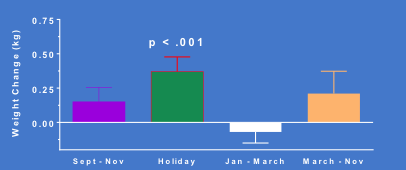 In a study of 200 Caucasian, African American, Hispanic, and Asian adults in which subjects did not know that the primary outcome measure was body weight, we found that weight gain from Thanksgiving Day to New Year's Day was only 0.37 kg, far less than the 2.27 kg (5 lb) commonly believed. Winter holiday weight gain may be a major contributor to annual weight gain in adults.
In a study of 200 Caucasian, African American, Hispanic, and Asian adults in which subjects did not know that the primary outcome measure was body weight, we found that weight gain from Thanksgiving Day to New Year's Day was only 0.37 kg, far less than the 2.27 kg (5 lb) commonly believed. Winter holiday weight gain may be a major contributor to annual weight gain in adults.
Yanovski JA, Yanovski SZ, Sovik KN, Nguyen TT, O'Neil PM, Sebring NG. A prospective study of holiday weight gain. N Engl J Med 2000;342(12):861-7. PMC4336296
Binge eating in children is associated with greater food intake as well as high body weight and adiposity and the complications of obesity.
Children who report episodes of binge eating or loss of control over eating weigh more and have more body fat than those who do not report such episodes, gain weight more rapidly over time, eat more during laboratory test meals, and have more components of the metabolic syndrome.
Tanofsky-Kraff et al; Pediatrics 2006;117: 1203-1209. PMC1863068; Mirch et al; Am J Clin Nutr 2006;84: 732-738. PMC1864961; Tanofsky-Kraff et al; Int J Obes (Lond) 2012;36: 956-962. PMC3454442
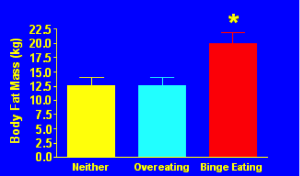
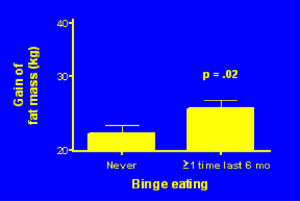
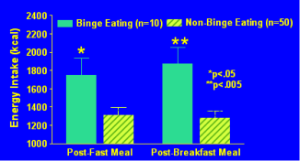
Metformin Treatment in the context of a behavioral modification program may help significantly overweight children lose weight.
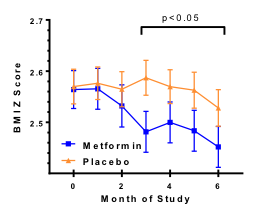 Over a 6-month treatment period, 100 children randomized to take metformin or placebo capsules (with a multivitamin) decreased their body weight more when treated with metformin than when taking the placebo.
Over a 6-month treatment period, 100 children randomized to take metformin or placebo capsules (with a multivitamin) decreased their body weight more when treated with metformin than when taking the placebo.
Yanovski et al; Diabetes 2011;60: 477-485. PMC3028347
Colchicine reduces inflammation and measures of insulin resistance in adults with metabolic syndrome.
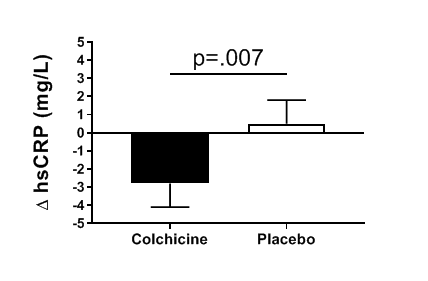
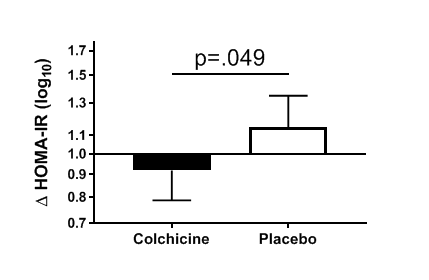
Over a 3-month treatment period, 40 adults randomized to take colchicine or placebo capsules twice-daily decreased their high-sensitivity C-Reactive Protein (hsCRP) and homeostasis model assessment of insulin resistance (HOMA-IR) index more when treated with colchicine than when taking the placebo.
Demidowich AP, Levine JA, Onyekaba GI, Khan SM, Chen KY, Brady SM, Broadney MM, Yanovski JA. Effects of colchicine in adults with metabolic syndrome: A pilot randomized controlled trial. In press, Diabetes Obes Metab 2019. PMC In Process
See Also:
 BACK TO TOP
BACK TO TOP